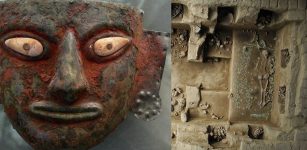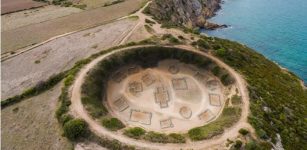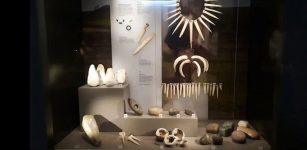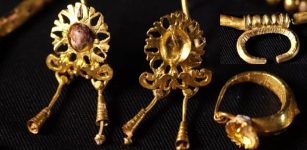Ledberg Stone (Ledbergsstenen) With Magic Formula Dated To Viking-Era – One Of Most Beautiful Landmarks
A. Sutherland - AncientPages.com - The Ledberg Stone (Ledbergsstenen) is considered one of Sweden's most beautiful Runestones. This landmark is also one of the country's more familiar runestones due to its beautiful and imaginative adornment. Some parts of its motif are taken from the famous religious myth of Ragnarök, the final battle in Norse mythology, in which several gods meet their death.
The Ledberg Stone (Ledbergsstenen) is considered one of Sweden's most beautiful Runestones. Image credit: Olof Ekström 2004-12-31. Transferred by Maksim (to commons) - CC BY-SA 3.0
Among other depictions on the stone, there is Fenrir (the Wolf) - the oldest of three terrible children of Loki, according to the literary works Poetic Edda (the Icelandic medieval manuscript known as the Codex Regius) and Snorri Sturluson's Prose Edda, and Heimskringla.
The Ledberg Stone - commonly dated to the 11th century - stands at Ledberg church, close to Ledberg Hill, Östergötland's largest burial mound.
The stone's unique ornamentation also depicts god Odin devoured by Fenrir when the whole world falls.
It is difficult to say if it is the Ragnarok drama that the ancient artists wanted to illustrate on this remarkable runestone. Still, there are certain similarities between the carved images and the events described in the legend of Ragnarok.
The runestone was built into the wall in Ledberg's old church for a couple of hundred years. It is not exactly known where the stone was initially erected.
However, the church was demolished in the 1850s, and the stone had to be removed.
On the front side of the stone, there are two helmet-adorned Viking warriors. One is depicted with a sword, spear, and shield, and the other only with a shield. On the front are also two animals and a ship.
Also, on the opposite side is the depiction of two warriors, but without weapons. Between these warriors, there is an animal. The figures have been interpreted as a representation of Ragnarok. According to this interpretation, The warrior is the god Odin who - on the stone's front side, is getting ready for battle, and then he encounters the ship Naglfar, which, according to legend, is manned by all the creatures of evil, and carries demonic forces to Ragnarok.
This great Norse story continues - through images - on the back of the Ledberg Stone, showing Odin attacked by the Fenris beast. Odin is defeated, and the great Battle is finally over.
As we find in "The Symbolism of Plants: The Gods of the Germanic Peoples," Volume 45, Volume 45, by Harry Eilenstein, on the Ledberg Stone is written:
"Square hole... his father, the two of them, Bise and Gunna (raised the stone)."
"On this runestone, which was built about 1050 for the name "Thorgautr," you can find a very special inscription (carved in the Younger futhark) with a magic formula.
The following three words are:
Thistle mistletoe kiste
That gives the sentence or, more precisely, the picture: "A thistle and a mistletoe in a box."
Why Were These Runes Important?
These runes would protect the stone from impact. This magic formula contains three magic words:
In ancient Norse beliefs, people believed that these words had magical properties. The same magic spell was discovered on many stones in the Nordic countries.
The Ledberg Stone is carved on three sides. Its third side is covered with the carving of a cross. It is dated to the 11th century.
Written by – A. Sutherland - AncientPages.com Senior Staff Writer
Updated on June 10, 2024
Copyright © AncientPages.com All rights reserved. This material may not be published, broadcast, rewritten or redistributed in whole or part without the express written permission of AncientPages.com
More From Ancient Pages
-
 On This Day In History: William Laud Archbishop Of Canterbury Beheaded – On Jan 10, 1645
News | Jan 10, 2017
On This Day In History: William Laud Archbishop Of Canterbury Beheaded – On Jan 10, 1645
News | Jan 10, 2017 -
 Ancient Trans-Atlantic Emigration Theory – Not Supported By Genetic Data, Researcher Says
Archaeology | Jan 18, 2016
Ancient Trans-Atlantic Emigration Theory – Not Supported By Genetic Data, Researcher Says
Archaeology | Jan 18, 2016 -
 Pottery Found On Jiigurru/Lizard Island Rewrites Aboriginal History
Archaeology | Apr 12, 2024
Pottery Found On Jiigurru/Lizard Island Rewrites Aboriginal History
Archaeology | Apr 12, 2024 -
 Ancient Tomb Of Peru’s Moche Priestesses Unearthed
Archaeology | Jul 23, 2016
Ancient Tomb Of Peru’s Moche Priestesses Unearthed
Archaeology | Jul 23, 2016 -
 How Did Indus Civilization Manage To Resist Climate Change?
Archaeology | Feb 22, 2017
How Did Indus Civilization Manage To Resist Climate Change?
Archaeology | Feb 22, 2017 -
 New Clues To Behavior Of Neanderthal Hunting Parties
Archaeology | Mar 27, 2023
New Clues To Behavior Of Neanderthal Hunting Parties
Archaeology | Mar 27, 2023 -
 Solar Cult Complex In The Temple Of Hatshepsut In Deir El-Bahari Reconstructed
Archaeology | Mar 2, 2015
Solar Cult Complex In The Temple Of Hatshepsut In Deir El-Bahari Reconstructed
Archaeology | Mar 2, 2015 -
 Amazing Ancient Roman Marble Floor Found In The Underwater City Of Baiae, Italy
Archaeology | Aug 5, 2024
Amazing Ancient Roman Marble Floor Found In The Underwater City Of Baiae, Italy
Archaeology | Aug 5, 2024 -
 LIDAR Discovers Circular Iron Age Village At Cap d’Erquy, France
Archaeology | Apr 4, 2024
LIDAR Discovers Circular Iron Age Village At Cap d’Erquy, France
Archaeology | Apr 4, 2024 -
 Ancient Goldsmith’s Toolkit Discovered Near Stonehenge
Archaeology | Dec 16, 2022
Ancient Goldsmith’s Toolkit Discovered Near Stonehenge
Archaeology | Dec 16, 2022 -
 On This Day In History: Foundation Stone Of The Royal Greenwich Observatory In London Was Laid – On August 10, 1675
News | Aug 10, 2016
On This Day In History: Foundation Stone Of The Royal Greenwich Observatory In London Was Laid – On August 10, 1675
News | Aug 10, 2016 -
 London’s Underground Rivers Were Deliberately Hidden
Featured Stories | Oct 8, 2018
London’s Underground Rivers Were Deliberately Hidden
Featured Stories | Oct 8, 2018 -
 Evidence Humans Have Visited Caves Of Nerja For 41,000 Years – Found!
Archaeology | Apr 25, 2023
Evidence Humans Have Visited Caves Of Nerja For 41,000 Years – Found!
Archaeology | Apr 25, 2023 -
 Look Inside The Magnificent Grotto Of Diana At Villa d’Este That Reopens After 50 Years
Places | Apr 29, 2025
Look Inside The Magnificent Grotto Of Diana At Villa d’Este That Reopens After 50 Years
Places | Apr 29, 2025 -
 Roman-Era Girl Buried And Adorned With 1,700-Year Old Gold Jewelry Found In Pagan Cave
Archaeology | Apr 8, 2023
Roman-Era Girl Buried And Adorned With 1,700-Year Old Gold Jewelry Found In Pagan Cave
Archaeology | Apr 8, 2023 -
 Mythical Temple Of Wingded Warrior God Haldi In The ‘City Of The Raven’
Civilizations | Jul 21, 2016
Mythical Temple Of Wingded Warrior God Haldi In The ‘City Of The Raven’
Civilizations | Jul 21, 2016 -
 Controversial Story And Secret Knowledge Of Li Ching-Yuen Who Lived For 256 Years
Featured Stories | Sep 19, 2015
Controversial Story And Secret Knowledge Of Li Ching-Yuen Who Lived For 256 Years
Featured Stories | Sep 19, 2015 -
 Did Easter Islanders Commit ‘Ecocide?
Places | Jun 22, 2024
Did Easter Islanders Commit ‘Ecocide?
Places | Jun 22, 2024 -
 First Complete Roman Funerary Bed Found In Britain
Archaeology | Feb 19, 2024
First Complete Roman Funerary Bed Found In Britain
Archaeology | Feb 19, 2024 -
 Long-Lost Burial Site Of Viking King Harald Bluetooth Discovered By Satellites?
Archaeology | Jun 29, 2022
Long-Lost Burial Site Of Viking King Harald Bluetooth Discovered By Satellites?
Archaeology | Jun 29, 2022

